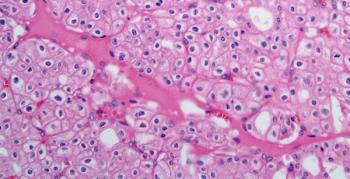
Patients with renal cell carcinoma whose disease progressed after previous VEGF therapy saw increased delays in disease progression when treated with lenvatinib.

Your AI-Trained Oncology Knowledge Connection!


Patients with renal cell carcinoma whose disease progressed after previous VEGF therapy saw increased delays in disease progression when treated with lenvatinib.

Follow-up of patients with resected non-metastatic RCC should be based on a combination of risk factors for disease recurrence and risk for non-RCC death.

A recent study highlights factors that predict worse prognosis for patients with germ cell tumors whose cancer has spread to the brain, including the presence of liver or bone metastases, multiple brain metastases, and others.

Older patients taking the oral TKIs sorafenib and sunitinib for RCC had a significantly increased risk for cardiovascular events, particularly stroke.

A new meta-analysis suggests that survival outcomes are similar with intermittent and continuous androgen deprivation therapy, and that intermittent therapy may improve some quality-of-life criteria.

Six months of radiation therapy combined with ADT for prostate cancer may not produce a survival benefit in men with moderate to severe comorbidities.

Men with low-risk prostate cancer monitored by active surveillance are not likely to have their disease spread to other organs or die of their prostate cancer.

Despite the clearly established overall health benefits of exercise, its role in reducing prostate cancer risk is unclear. Whereas some studies found often dramatic reductions in prostate cancer risk, others found no effect.

In most cases, localized small-cell bladder cancer requires cystectomy for optimal cure rates.

Radiation therapy with concurrent chemotherapy is an effective treatment strategy for small-cell bladder cancer.

Use of the diabetes drug pioglitazone was not associated with a significantly increased risk of bladder cancer, in a large cohort study.

Patients who have undergone chemotherapy for nonseminoma testicular cancer are at an increased risk for cardiovascular disease, especially in the first year after treatment.

Adding chemotherapy to hormonal therapy in men with metastatic hormone-sensitive prostate cancer increased improved overall survival by 13.6 months.

A 20-year-old young man presents with hypertension and a left kidney mass. After further evaluation, a biopsy is performed. What is your diagnosis?

Researchers have identified a subset of six biomarkers that together may predict the risk of more aggressive prostate cancer among African American men.

The 2015 ASCO Annual Meeting delivered new practice-changing results in the area of prostate cancer.

In this interview we discuss recent trials that looked at the use of upfront chemotherapy combined with androgen deprivation therapy in men with metastatic prostate cancer and how they have changed clinical practice.

In this interview, Dr. Mario Eisenberger talks about potential new combination therapies for advanced prostate cancer that are currently being tested in clinical trials.

The management of patients with localized prostate cancer has improved to meet clinical guidelines, according to a new study.

A 63-year-old man presents with a mass in the left kidney. After further evaluation, a biopsy is performed. What is your diagnosis?

For the first time, researchers say they have been able to use a prostate fusion biopsy to determine which tumors are the most aggressive.

PSA-based screening for prostate cancer among men older than 50 has decreased since the 2012 USPSTF recommendations.

Thanks to the efforts of the Prostate Cancer Foundation and Movember, men of good will (especially those inclined to grow mustaches and raise awareness and funds each year) and their physicians are newly energized to make progress.

Here we discuss the efficacy and safety of zoledronic acid, denosumab, enzalutamide, abiraterone, and radium-223 and review the available data regarding the cost of denosumab compared with that of zoledronic acid.

Enhanced control of osseous metastases with both systemic life-extending therapies and bone-support medications has meaningful clinical impact for prostate cancer patients.